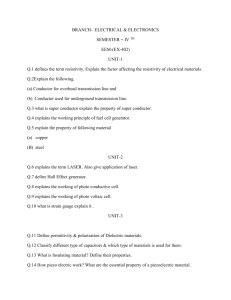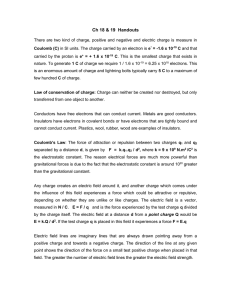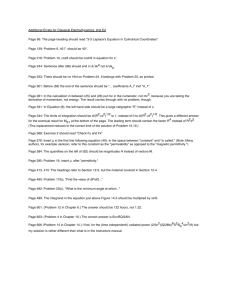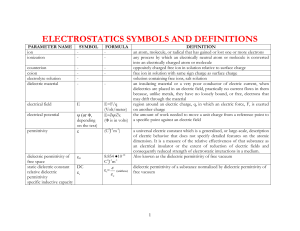Mitigation of Power Loss Due to Skin Effect by Thin
advertisement
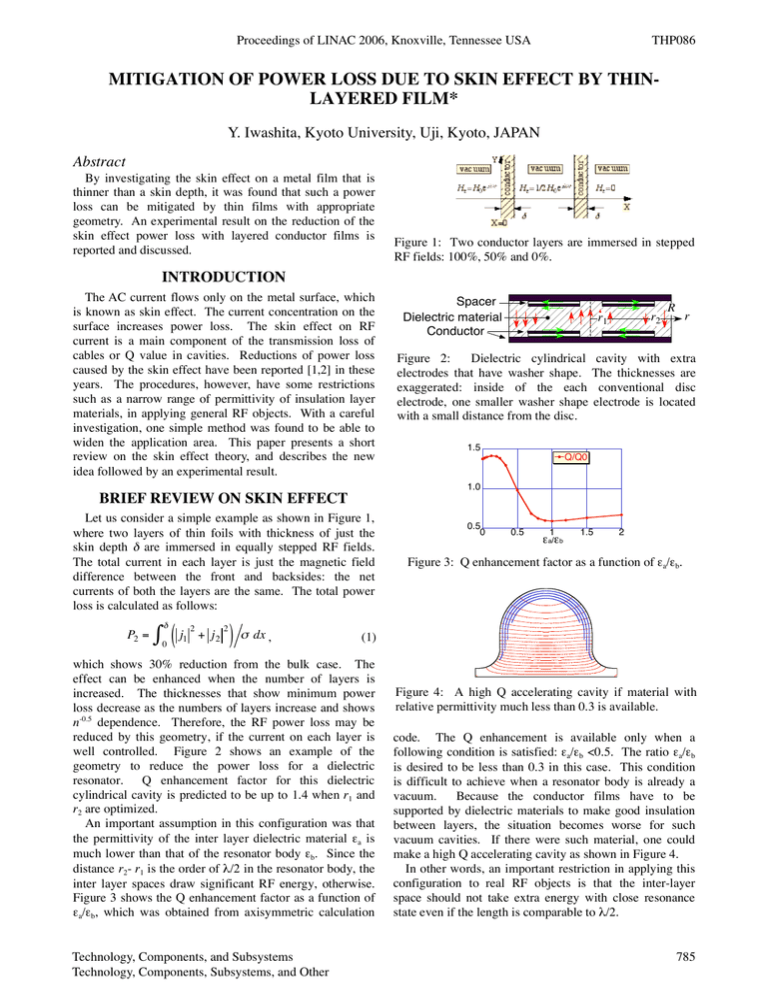
Proceedings of LINAC 2006, Knoxville, Tennessee USA THP086 MITIGATION OF POWER LOSS DUE TO SKIN EFFECT BY THINLAYERED FILM* Y. Iwashita, Kyoto University, Uji, Kyoto, JAPAN Abstract By investigating the skin effect on a metal film that is thinner than a skin depth, it was found that such a power loss can be mitigated by thin films with appropriate geometry. An experimental result on the reduction of the skin effect power loss with layered conductor films is reported and discussed. Figure 1: Two conductor layers are immersed in stepped RF fields: 100%, 50% and 0%. INTRODUCTION The AC current flows only on the metal surface, which is known as skin effect. The current concentration on the surface increases power loss. The skin effect on RF current is a main component of the transmission loss of cables or Q value in cavities. Reductions of power loss caused by the skin effect have been reported [1,2] in these years. The procedures, however, have some restrictions such as a narrow range of permittivity of insulation layer materials, in applying general RF objects. With a careful investigation, one simple method was found to be able to widen the application area. This paper presents a short review on the skin effect theory, and describes the new idea followed by an experimental result. Let us consider a simple example as shown in Figure 1, where two layers of thin foils with thickness of just the skin depth are immersed in equally stepped RF fields. The total current in each layer is just the magnetic field difference between the front and backsides: the net currents of both the layers are the same. The total power loss is calculated as follows: (j 0 1 2 + j2 2 ) dx , R r Figure 2: Dielectric cylindrical cavity with extra electrodes that have washer shape. The thicknesses are exaggerated: inside of the each conventional disc electrode, one smaller washer shape electrode is located with a small distance from the disc. 1.5 Q/Q0 0.5 0 0.5 1 a/b 1.5 2 Figure 3: Q enhancement factor as a function of a/b. (1) which shows 30% reduction from the bulk case. The effect can be enhanced when the number of layers is increased. The thicknesses that show minimum power loss decrease as the numbers of layers increase and shows n-0.5 dependence. Therefore, the RF power loss may be reduced by this geometry, if the current on each layer is well controlled. Figure 2 shows an example of the geometry to reduce the power loss for a dielectric resonator. Q enhancement factor for this dielectric cylindrical cavity is predicted to be up to 1.4 when r1 and r2 are optimized. An important assumption in this configuration was that the permittivity of the inter layer dielectric material a is much lower than that of the resonator body b. Since the distance r2- r1 is the order of /2 in the resonator body, the inter layer spaces draw significant RF energy, otherwise. Figure 3 shows the Q enhancement factor as a function of a/b, which was obtained from axisymmetric calculation Technology, Components, and Subsystems Technology, Components, Subsystems, and Other r2 r1 1.0 BRIEF REVIEW ON SKIN EFFECT P2 = Spacer Dielectric material Conductor Figure 4: A high Q accelerating cavity if material with relative permittivity much less than 0.3 is available. code. The Q enhancement is available only when a following condition is satisfied: a/b <0.5. The ratio a/b is desired to be less than 0.3 in this case. This condition is difficult to achieve when a resonator body is already a vacuum. Because the conductor films have to be supported by dielectric materials to make good insulation between layers, the situation becomes worse for such vacuum cavities. If there were such material, one could make a high Q accelerating cavity as shown in Figure 4. In other words, an important restriction in applying this configuration to real RF objects is that the inter-layer space should not take extra energy with close resonance state even if the length is comparable to /2. 785 THP086 Proceedings of LINAC 2006, Knoxville, Tennessee USA LOCAL RESONANCE CONTROL Figure 5(left) shows the schematic picture of such a local resonance model. This structure acts as a /2 mode resonator when a condition meets; electric and magnetic field distributions have a node and an antinode at the center, respectively. This can be described by an equivalent circuit model as shown in Figure 5(right). The local resonant frequency can be raised by reducing L and/or C as shown in Figure 6: to widen the gap at the edge areas and narrow the gap at the center area. Because these gap widths should be much smaller than the film length, the effect can be described by the gap stepping ratio d2/d1. The effect of such an operation is evaluated by SUPERFISH calculations as a boundary condition problem as shown in Figure 7. The factor of the raised frequency is shown in Figure 8 as a function of the gap ratio d2/d1. Considering the resonator with the large gap ratio as two separate resonators (each of the length becomes a half), a large limiting value of the factor should be 2. This effect is equivalent to using a dielectric material with permittivity of 0.25. A practical limit of the frequency factor may be 1.8 since hundred times of 1μm narrower gap width is already 0.1mm and the slope is rather flat at the higher domain in Figure 8. This value corresponds to the permittivity of 0.3, which reaches the value stated above. E Figure 5: Left: local resonance at inter layer space and Right: its equivalent circuit E E B Figure 6: Raised local resonant frequency. 25cm d1=50μm d2 Figure 7: Evaluation of local resonant frequency. 2.0 f(d2)/f(d1) 1.8 1.6 1.4 MEASUREMENT ON COAXIAL CAVITY 1.2 The effect was experimentally tested on a coaxial cavity, because it has a simple electromagnetic field distribution (see Figure 9). A thin film (5μm copper layer on 25μm polyimide [3]) was put on the inner conductor with its polyimide side down to form an insulation layer. Because the film has to be located at the high magnetic field region, the resonant mode for the measurement was the second lowest mode that has an antinode of its magnetic field at the center; other antinode regions are located at the ends and are difficult to put the films. The film locally covers the center inner region and the Q values were measured while changing the length by cutting from its edges step by step. The length of the film can control the total current on the film that goes in and out as a displacement current. The cavity has length of 2m to have its second lowest frequency 150MHz (=2m). The skin depth of the copper conductor at this frequency is 5.4μm. 80cm of the center region is initially wrapped around where the film was put directly on the inner most 30cm region while the outer areas have spacer layers by putting polyethylene meshes with 300μm thickness (see Figure 11). The Q-value was measured while the edges of the film were shortened. The measured result is shown in Figure 12. The ordinate shows a ratio Q/Q0, where Q0 is the measured Q-value when all the film was removed lastly. The abscissa shows a relative length of the covered length by film to /2. Because the observed frequency change was less than 10-3 and the volume under the conductor foil is very small 1.0 786 E B 0 10 20 30 40 Ratio (d2/d1) 50 60 70 Figure 8: Resonant frequency as a function of gap ratio. E Z Figure 9: Experiment on a coaxial cavity. Figure 10: Photo of the coaxial cavity Figure 11: Polyethylene mesh as a spacer. Technology, Components, and Subsystems Technology, Components, Subsystems, and Other Proceedings of LINAC 2006, Knoxville, Tennessee USA and = j 0 . Because the calculation only included power losses on the inner conductor and the conductor foil, the relative calculated values Q/Q0 were compensated by following factors: 1) the outer conductor had 2.5 time larger radius than that of inner one, which gives factor 1.4 for total power loss. 2) it did not include the right most quarter area where the film was not put; this gives another factor 2. Thus the differences were supposed to be diluted with this factor, which is denoted in the legend of the figure. Although the power losses at the endplate were not counted in this calculation, the results agreed with the measured data, considering the difficulty in setting the film on the inner conductor with the polyethylene mesh. DISCUSSIONS As one can already imagine, the stepped foil configuration can also be applied to a dielectric cavity with uniform permittivity (see Figure 14). Figure 15 shows the calculated enhancement factors of the Q-value, where the stepping ratio d2/d1 =8. It also shows the case with no step while the permittivity of the spacer layer is set much smaller (10-4) than that of resonator body. The effect of the step is close to use of the low permittivity material in this case. Although only the first quadrant is calculated using the symmetries, the values directly reflect the real case. The Q-value enhancement is also expected in this example. Because this resonator needs high permittivity and low loss dielectric material for its body, which is not easy, the experimental proof is a future subject. Reducing RF losses of waveguide and accelerating cavity are one of the final goals of this study. Although the restriction on the permittivity can be reduced, only the stepping configuration is not enough to achieve the enhancement yet, because these RF objects have longer wall distances compared with the wavelength (see Figure 16). More sophisticated idea is needed for these kind of RF objects. ACKNOWLEDGEMENT The author would like to thank Dr. H. Fujisawa and Mr. H.Tongu for their technical help in measuring the Q value. Technology, Components, and Subsystems Technology, Components, Subsystems, and Other 1.2 Q/Q0 (experiment) (Q/Q0-1)/2.8+1 d0 1.1 Ratio compared with the cavity body, the electromagnetic field distribution should not have changed very much. The value of more than unity shows that the real power loss reduction was achieved with this scheme. The calculations were based on a configuration shown in Figure 13. In order to reduce the computation resources, the total system was scaled to 3GHz and the relative permittivity was set as 104 instead of 1. The power losses in conductors are included by assigning complex permittivity. The value was chosen as (1, 0.35 x 109) considering following equation: ˙ + E = ( j + ) E = j + E rotH = D 0 0 j 0 THP086 1.0 0.9 0.8 0.7 0 20 40 % 60 80 100 Figure 12: Measured and calculated Q values 1=104 d250μm =8μm 2 d1=0.5μm t=1μm 75μm r=97μm 2=(1, 0.35e9) r=80μm r=70μm Figure 13: Geometry for the Q value estimation. Figure 14: Stepped foil structure for dielectric resonator. 1.50 1.40 1.30 1.20 1.10 1.00 0.90 0.80 0.70 0 Q/Q0 d=1μm =1 Q/Q0 d=1μm stepx8 50 100 150 r [μm] 200 250 Figure 15: Calculated Q enhancement for dielectric cavity. 0.46c~c/2 Figure 16: A possible stepped foil configuration in a circular waveguide. REFERENCES [1] J. Hattori, et al.: Low Profile Dielectric Band Elimination Filter using Thin Film Layered Electrode for 2GHz Band Cellular Base Station, IEEE MTT-S Digest 1999 [2] http://accelconf.web.cern.ch/AccelConf/l04/papers/THP43.pdf [3] http://www.toray-taf.co.jp/img/product_group/Metaloyal.pdf 787
